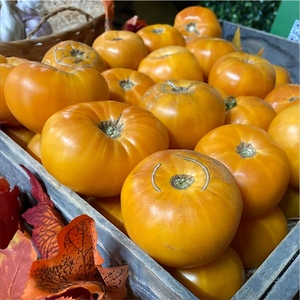


Persimmon Heirloom Tomatoes
Estimated Inventory, lb : 0
Description/Taste
The Persimmon tomato is a golden fruit the color of an egg yolk. Its rich flesh is the same lively color of the skin. Because the Persimmon tomato’s seed cavities are very small it has a higher concentration of solid flesh than many other varieties. It has a marvelous flavor—low in acidity, creamy, and fruity. Unlike so many heirloom tomatoes, persimmons have a skin that is resistant to cracking. This quality, along with its flavor and short growing season, make this a coveted cultivar for farmers and gardeners. Persimmon tomatoes typically weigh between one and two pounds.
Seasons/Availability
Persimmon tomatoes are available in summer and early fall.
Current Facts
This tomato is botanically classified as Solanum tuberosum cv. Persimmon. The Persimmon tomato belongs to the Solanaceae, or nightshade, family, along with other plants such as sweet peppers, petunias, and tobacco. Their large size and delicious raw flavor (which is best displayed when eaten fresh) classify the Persimmon tomato as a “beefsteak” tomato. Persimmon tomatoes are different from the fruit of the persimmon tree which belongs to a wholly different family, Ebenaceae.
Nutritional Value
Persimmon tomatoes are high in vitamins C, K, and A. These vitamins help the body to maintain healthy skin, hair, and bones, and also guard against heart disease.
Applications
Persimmon tomatoes can be used in a wealth of different culinary applications. Their flavor is best displayed raw in a salad, sandwich, or on its own, perhaps with a dash of salt. You can also create a gorgeous presentation by making a persimmon tomato tart. Simply bake a pie shell, fill it with a thin layer of ricotta cheese, top with slices of the persimmon tomato, and dress with vinegar and oil. They can also be briefly treated with heat. For example, the persimmon tomato can be sautéed and added to pasta or grilled for use as a pizza topping.
Ethnic/Cultural Info
The history of the persimmon tomato is a murky one. Some sources state that it was grown by Thomas Jefferson at Monticello, while others claim that it did not come into cultivation until the 1880’s. Still others write that the persimmon tomato was bred in Russia. Regardless of its origins and age, the persimmon tomato has enjoyed a place of eminence among tomato aficionados for generations.
Geography/History
The tomato as we know it began being cultivated by the Aztecs in Central America. After their invasion the conquistadors brought the tomato to Europe where it was met with mixed reviews. Some countries dabbled with the new ingredient in their cuisines while others met the tomato with suspicion, believing it to be poisonous. However, even Europeans who didn’t trust the tomato as an edible crop, such as the British, grew the fruit in their garden, as they found it to be an ornamental curiosity. This aesthetic appreciation was so strong that the British colonists brought tomato seeds with them when they traveled to the “new world,” though they were not accepted as an edible crop until Thomas Jefferson began cultivating them at Monticello. From Virginia the tomato steadily grew in popularity throughout the United States. Today, tomatoes are the most commonly grown fruit in the world, more popular than apples or even bananas.
Recipe Ideas
Recipes that include Persimmon Heirloom Tomatoes. One
| A Cozy Kitchen |
|
Heirloom BLT Pizza |
| My Recipes |
|
Halibut with Persimmon Tomato and Dill Remoulade |
| The Roasted Root |
|
Heirloom Tomato & Avocado Farro Salad with Lime-Mint Dressing |
Podcast












